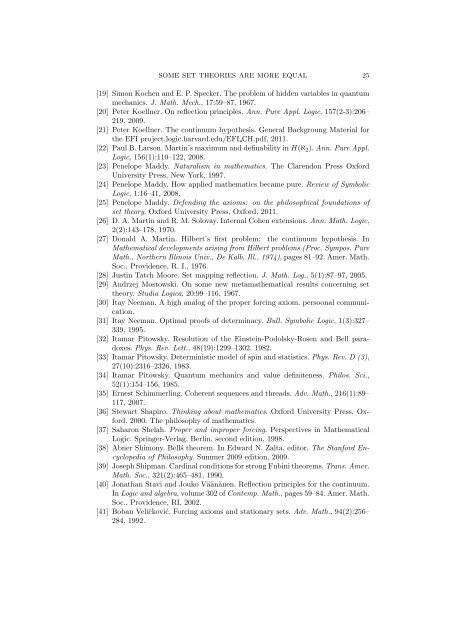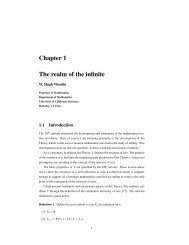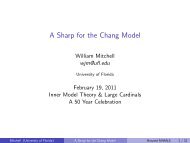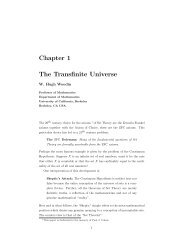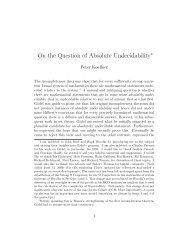SOME SET THEORIES ARE MORE EQUAL ... - Logic at Harvard
SOME SET THEORIES ARE MORE EQUAL ... - Logic at Harvard
SOME SET THEORIES ARE MORE EQUAL ... - Logic at Harvard
Create successful ePaper yourself
Turn your PDF publications into a flip-book with our unique Google optimized e-Paper software.
<strong>SOME</strong> <strong>SET</strong> <strong>THEORIES</strong> <strong>ARE</strong> <strong>MORE</strong> <strong>EQUAL</strong> 25[19] Simon Kochen and E. P. Specker. The problem of hidden variables in quantummechanics. J. M<strong>at</strong>h. Mech., 17:59–87, 1967.[20] Peter Koellner. On reflection principles. Ann. Pure Appl. <strong>Logic</strong>, 157(2-3):206–219, 2009.[21] Peter Koellner. The continuum hypothesis. General Backgroung M<strong>at</strong>erial forthe EFI project,logic.harvard.edu/EFI CH.pdf, 2011.[22] Paul B. Larson. Martin’s maximum and definability in H(ℵ 2 ). Ann. Pure Appl.<strong>Logic</strong>, 156(1):110–122, 2008.[23] Penelope Maddy. N<strong>at</strong>uralism in m<strong>at</strong>hem<strong>at</strong>ics. The Clarendon Press OxfordUniversity Press, New York, 1997.[24] Penelope Maddy. How applied m<strong>at</strong>hem<strong>at</strong>ics became pure. Review of Symbolic<strong>Logic</strong>, 1:16–41, 2008.[25] Penelope Maddy. Defending the axioms: on the philosophical found<strong>at</strong>ions ofset theory. Oxford University Press, Oxford, 2011.[26] D. A. Martin and R. M. Solovay. Internal Cohen extensions. Ann. M<strong>at</strong>h. <strong>Logic</strong>,2(2):143–178, 1970.[27] Donald A. Martin. Hilbert’s first problem: the continuum hypothesis. InM<strong>at</strong>hem<strong>at</strong>ical developments arising from Hilbert problems (Proc. Sympos. PureM<strong>at</strong>h., Northern Illinois Univ., De Kalb, Ill., 1974), pages 81–92. Amer. M<strong>at</strong>h.Soc., Providence, R. I., 1976.[28] Justin T<strong>at</strong>ch Moore. Set mapping reflection. J. M<strong>at</strong>h. Log., 5(1):87–97, 2005.[29] Andrzej Mostowski. On some new metam<strong>at</strong>hem<strong>at</strong>ical results concerning settheory. Studia <strong>Logic</strong>a, 20:99–116, 1967.[30] Itay Neeman. A high analog of the proper forcing axiom. persoonal communic<strong>at</strong>ion.[31] Itay Neeman. Optimal proofs of determinacy. Bull. Symbolic <strong>Logic</strong>, 1(3):327–339, 1995.[32] Itamar Pitowsky. Resolution of the Einstein-Podolsky-Rosen and Bell paradoxes.Phys. Rev. Lett., 48(19):1299–1302, 1982.[33] Itamar Pitowsky. Deterministic model of spin and st<strong>at</strong>istics. Phys. Rev. D (3),27(10):2316–2326, 1983.[34] Itamar Pitowsky. Quantum mechanics and value definiteness. Philos. Sci.,52(1):154–156, 1985.[35] Ernest Schimmerling. Coherent sequences and threads. Adv. M<strong>at</strong>h., 216(1):89–117, 2007.[36] Stewart Shapiro. Thinking about m<strong>at</strong>hem<strong>at</strong>ics. Oxford University Press, Oxford,2000. The philosophy of m<strong>at</strong>hem<strong>at</strong>ics.[37] Saharon Shelah. Proper and improper forcing. Perspectives in M<strong>at</strong>hem<strong>at</strong>ical<strong>Logic</strong>. Springer-Verlag, Berlin, second edition, 1998.[38] Abner Shimony. Bellś theorem. In Edward N. Zalta, editor, The Stanford Encyclopediaof Philosophy. Summer 2009 edition, 2009.[39] Joseph Shipman. Cardinal conditions for strong Fubini theorems. Trans. Amer.M<strong>at</strong>h. Soc., 321(2):465–481, 1990.[40] Jon<strong>at</strong>han Stavi and Jouko Väänänen. Reflection principles for the continuum.In <strong>Logic</strong> and algebra, volume 302 of Contemp. M<strong>at</strong>h., pages 59–84. Amer. M<strong>at</strong>h.Soc., Providence, RI, 2002.[41] Boban Veličković. Forcing axioms and st<strong>at</strong>ionary sets. Adv. M<strong>at</strong>h., 94(2):256–284, 1992.


